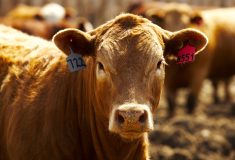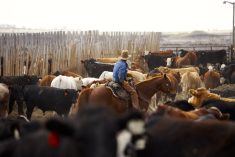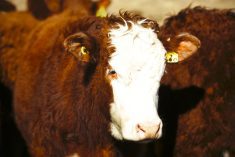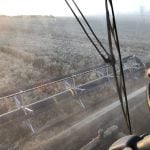As the national cow herd shrinks, demographics shift and technology disrupts marketing, auction marts are figuring out how to adapt
Western tradition is on display at the auction mart conference in Olds, Alta. People in cowboy hats and boots fill the conference room at the hotel. And the residents of Olds are very familiar with Western culture — even some of the town’s “welcome” signs depict bull riding.
But as important as those traditions are, it’s evident that both the town of Olds and Canada’s auction mart industry are facing constant change, and the challenges those changes bring.
Read Also

Canadian Roundtable for Sustainable Beef faces supply crunch
It’s been over 10 years since the Canadian Roundtable for Sustainable Beef was established, and though the roundtable has made…
Jason Danard, who was elected president of the Livestock Markets Association of Canada at the association’s annual convention in May 2023, moderates the panel regarding the viability of the livestock markets — specifically, if how they are run now is sustainable for the long term. It ends up being a nearly two-hour discussion.
“This has been a really good panel discussion. I’m really happy that we went and did this because it’s like we’re all sitting around the coffee table talking about our business, and what is really promising is the positivity coming out of this, that we are sustainable,” says Rick Wright, the association’s executive administrator.
Industry challenges
The sustainability of the industry is not a new conversation for the people who attended the association’s convention. In fact, it’s one that professionals in this industry think about constantly as things change around the auction marts.
COVID slammed into the world in 2020, affecting every person and industry. Like many businesses, auction marts struggled with labour and staffing issues, a problem that lingers to this day.
Another issue auction marts still grapple with is the declining national herd — something that started as early as 2006, and has been steadily shrinking ever since.
The Canadian herd dropped to 12.3 million animals in 2022, which is the smallest it’s been since 1988. Drought that plagues the Prairies exacerbates this issue, with producers culling more cattle as a direct result of 2020 and 2021. Although conditions have improved in some areas, drought clings to some regions in Saskatchewan and Alberta.
Finally, another factor is the shift to online sales and marketing, as well as the direct marketing that some ranchers do, which lures more producers away from the stockyards.
With all of these issues at the neck of the auction yards, professionals in the industry are constantly asking themselves how much longer they can keep doing what they’re doing, the way they’ve been doing it.
Panelists recognize that as the industry changes, auction marts must adapt to stay in the game.
Aging generation
Rob Bergevin has been in the livestock industry for many years and has seen a lot of changes and challenges that could threaten the industry come to be. As both an auctioneer and the owner/operator of Foothills Livestock Auction in Stavely, Alta., Bergevin is passionate about the industry.
He noted some of the things that worry him about the future of auction marts, including the median age for producers going up, with less uptake from the younger generation.
“I do have some fear about where we’re going with the declining numbers,” Bergevin says. “And these are some of the challenges that I see that as market operators, we need to address.”
Bergevin also mentioned rising costs.
“Land values and meeting the cost of everything has gone up. And so it’s making it challenging for young producers to get in.”
Dan Skeels is well known in the industry, mostly for his work as an auctioneer, where he’s become somewhat of a legend for his many accomplishments, including winning the world championship in 2004.
However, when Skeels isn’t behind a mic, he’s right at home in a pen of cattle. He operates his own ranch of purebred Simmentals, known as Anchor D Ranch. As a producer, Skeels also sees how hard it is for young people to break into farming and ranching.
“Unfortunately, in the industry that we’re in right now, just with costs, the cost of land, cost of equipment … it’s pretty tough,” Skeels says. “If you’re not from a family farm, you’re probably not going to start up farming tomorrow. So, will the landscape change in the next 10 years? Yes, I’m afraid it probably will.”
Shrinking market
With the landscape changing, panelists foresee fewer auction marts in the near future.
“Competition is tight. I’m not so sure that we don’t have too many auction markets,” says Bergevin. “That’s my personal view. In Canada, and particularly in Alberta, I believe that we’re going to start to see either closures or mergers.”
Skeels echoes this statement, saying it’s unlikely auction mart numbers will remain stable.
“We’re going to lose some markets which I absolutely hate to see,” Skeels says. “I mean, I’d like to see more markets. But that’s just the reality of where we’re at right now.”
Bergevin, however, remains positive about the overall outlook of the industry.
“I think that there’s a lot of other opportunities that we can take advantage of. I think we have to collectively come together and decide how we’re going to diversify, how we can develop electronic marketing, how we can best serve our producers,” he says.
Wright also has confidence in the general outlook for auction marts.
“There are going to be changes but we still are a valuable part of the livestock industry,” he says. “And I think you’ve heard from all the facets that are sitting at the table here. So that is so encouraging moving forward in our particular business.”
Skeels says markets remain integral to the beef industry. For example, he says, producers direct-marketing their cattle often use a market report to help determine their sales prices.
“You use the market. You have no idea how much the market does for you to add value to your program, yet you don’t support it. And that’s the importance of supporting and promoting the industry, in my personal opinion, because of the value that the markets add to the industry.”
“(They) really do look out for the good of the consumer, the cow-calf producer that’s bringing the cattle in,” says another panelist, Scott Anderson. Anderson runs a bred heifer program at Bowden, Alta.
“I do see some cases where people do drive a long distance and they want to literally go to that auction mart for that reason. And that truly is a reflection of their trust in that facility.”
Bowden says small producers need the market to survive.
Bergevin says auction marts play an important role in the economy, and support communities.
“I know from our personal perspective that Staveley would not be thriving as much as it is now if the market wasn’t there … the coffee shop, the hotel bar, or the places that certainly seem to make economic spinoff from the market being there.”
Outreach
With all the opportunities and challenges ahead of the industry, panelists see a need to connect with the public to help ensure the auction mart industry’s future.
“I think it really all stems back, to me, to education,” says Bergevin. “And so, you know, we have an opportunity to continue to educate our producers in that, and the ability to educate and recruit people because it is a great business.”
This means connecting with consumers who aren’t aware of the work being done in auction marts, and only understand what they are at a surface level. It also means piquing the interest of young people, to get them engaged in the business of auction marts.
“None of us are naive to the work that goes on in the fall. And so it’s encouraging those guys to maybe move on in different directions, give them opportunities to work towards maybe becoming an auctioneer, or working as a clerk, or working in a different level of the market. But I think a lot of most of that stuff just stems from education and support,” says Bergevin.

















